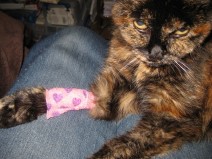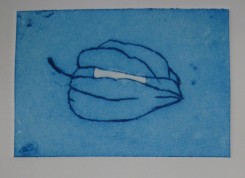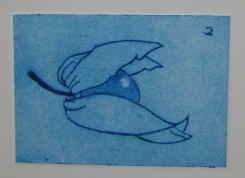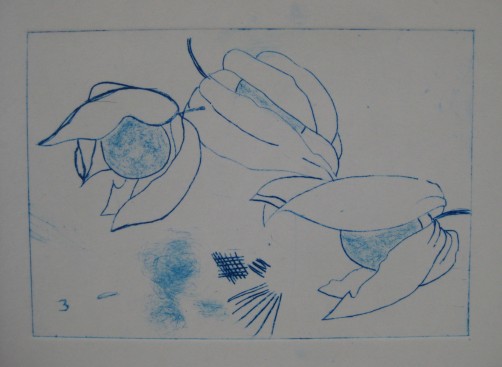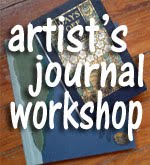I’ve been preoccupied this summer with a sick cat. As I said in June, our 18 year old tortie Wysi ‘crashed’ due to CRF and needed a lot of care (including 2 hourly feeds for a few weeks). Just as we got her CRF stabilised, she was diagnosed as hyperthyroid. She’s been on medication for that for a month now, and she is having a lot of gut problems which may be due to that medication or may be due to her CRF. She’s had 3 stays at the vet’s on IV, from which she comes home with a pretty bandage on one leg (doesn’t she look impressed with that?), and too many other visits for me to count. I hope we’ll get her re-stabilised soon, for her sake and ours.
So, I’ve not had much craft stuff to blog about recently. I have done a little more of the Icarus, though I need to tink a couple of rows as I lost concentration while knitting at our monthly spinning evening – no pictures of that, though.
We went to a 2-day printmaking workshop with Karen Carter last month. Because we were shown how to use the etching press safely, that ‘qualified’ us to go to the monthly printmaking afternoons at the college, which we did last Saturday. The workshop covered collagraphs, drypoint ‘etching’ and linocuts. DH did some amazing drypoint prints, but I just did a lot of test prints and samples. I decided to use the same drawings I’d used for the monoprints in April so I could compare the difference in line quality more easily (and because I was too brain-dead that week to come up with new images). These are not supposed to be aesthetically interesting – just trying out techniques. I also used the backgrounds to try some different effects.
Drypoint is a technique which produces prints which look like etchings, but instead of using acid, you ‘draw’ your image onto a synthetic plate with a needle tool, or add texture with an abrasive. I started with a ‘frosted’ translucent polypropylene sheet – the kind sometimes used to make filing folders. One side is more textured than the other – the first sample is the smoother side.
Next I tried using a sheet of Rhenalon, which is smooth and transparent. I found it more difficult to use than the polypropylene, as if I used enough pressure to get a clear line the tool slipped too easily. DH preferred it, though, as he likes the clear background.
I also did some collagraph samples at the workshop, and although I didn’t have time to do any linocuts there, I did get one done at the open studio. I’ll try to get scans or photos of those soon and post them here.
